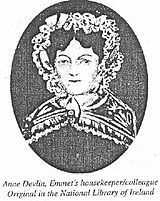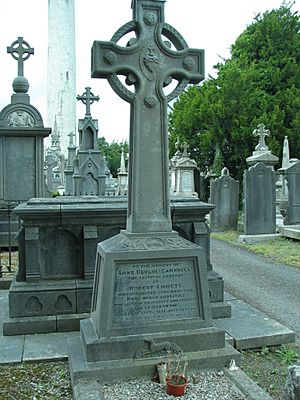Anne Devlin facts for kids
Quick facts for kids
Anne Devlin
|
|
|---|---|

Portrait of Anne Devlin
|
|
| Born | 1780 Rathdrum, County Wicklow, Ireland
|
| Died | 18 September 1851 (aged 70–71) |
| Resting place | Glasnevin Cemetery, Dublin, Ireland |
| Nationality | Irish |
| Occupation | Patriot |
| Known for | United Irish rebel |
Anne Devlin (1780 – 1 September 1851) was a brave Irish woman who worked to make Ireland a free country. In 1803, she secretly helped Robert Emmet and her cousin, Michael Dwyer, plan a new uprising against the British rulers. Their plan for a rebellion in Dublin, the capital city, did not go as hoped. Anne was arrested and treated very badly while in prison. People were so upset by how she was treated that she was released in 1806. The Emmet family helped her for a while. She worked for many years as a laundress, washing clothes, but later in life, she became very poor.
Contents
Anne Devlin's Role in the Irish Rebellion
Anne Devlin was born in Cronebeg, a small place near Aughrim in County Wicklow. Her parents were Wynnie Byrne and Bryan Devlin. Her family later moved to a farm near Rathdrum. Even though the land was meant for Protestant families only, her father was able to rent a part of it from the Earls of Strafford.
In 1796, Anne's parents got her a job as a maid in Dublin, working for the Earl of Strafford's sister-in-law. But the government was very harsh towards people who wanted Ireland to be free. Anne's father called her home. When the rebellion started in May 1798, Anne was working as a kitchenmaid. Neither she nor her family took part in the fighting. However, Anne stayed in touch with her cousin, Michael Dwyer, who led a group of fighters in the Wicklow Mountains. She bravely helped to bury the bodies of rebels who had been executed. In 1799, her father was arrested and held in Wicklow Goal for two and a half years. Anne visited him every two weeks to bring him food and clothes.
After her father was released in May 1801, the Devlin family moved to Rathfarnham, County Dublin. There, Anne met Robert Emmet. He had just returned from France and was now leading a new, secret group of Irish rebels. Anne's father offered Emmet a safe place to stay in their home. Emmet decided to rent a house nearby instead. To make it look like a normal gentleman's home, he asked Anne to pretend to be his housekeeper. Anne was not paid; she was a secret helper. Emmet once said, "she is one of ours," showing how much he trusted her.
Anne helped Emmet and James Hope arrange meetings with her cousin Dwyer in April 1803. Dwyer promised to bring his men from the mountains to help the rebels in Dublin. Anne also helped prepare for the uprising in the city. She moved weapons and supplies from the main rebel base to other parts of Dublin.
On the evening of 23 July, the rebellion in Dublin began. But there was not enough support from the people, and the rebels became confused. The uprising quickly fell apart, leading to a night of street fights. Soon after, soldiers arrived at the house where Anne was staying. They arrested Anne and her eight-year-old sister. Anne was questioned and treated badly, but she did not tell them anything important. The soldiers eventually left. Later, Anne and her whole family were arrested again after a neighbor told on them.
Anne Devlin's Arrest and Time in Prison
The authorities knew Anne was very important to the rebel plans. She was questioned in Dublin Castle by Henry Charles Sirr, the police chief. Anne refused to tell them anything about Emmet, even when they threatened her or offered her rewards. She was then taken to Kilmainham Goal. Emmet, who was not defending himself, even told her to testify against him to save herself. To try and make her talk, her whole family was put in jail. This caused her nine-year-old brother to become sick and die. But Anne still refused to help the authorities.
In 1806, her jailer moved her to the tower of Dublin Castle to prevent her from being released with other prisoners. However, a friend kept trying to help her. The new Irish Chief Secretary, Charles Long, visited her. He was shocked to find Anne so ill she could barely move. He ordered her release.
Anne Devlin's Later Life
After being released from prison in 1806, Anne worked as a maid for friends of the Emmet family for about four years. In 1835, she likely worked as a laundress at St Patrick's Hospital Dublin. She might have gotten this job through the Emmet family again, as Dr. Robert Emmet had worked at the hospital for many years.
In 1830, a Carmelite brother named Luke Cullen interviewed Anne many times. He was collecting stories about the rebellions of 1798 and 1803. His notes were later published in 1968 as The Anne Devlin Jail Journal. There is no record of Anne taking part in any more political actions after her release.
In the late 1830s, the hospital hired a new laundress who cost much less than Anne. In 1842, a historian named R. R. Madden found Anne. She was washing clothes at home and was very sick. A collection of £5 was raised for her by a newspaper called The Nation, but it was not enough to stop her from becoming very poor. Her husband, with whom she had two children, died in 1845. Six years later, Anne died in a poor part of Dublin called the Liberties. It is thought she died from starvation.
Anne Devlin is buried in Glasnevin Cemetery. Her body was moved there from a pauper's grave in 1852 by Madden and his friends. A large Celtic cross now marks her grave, which is looked after by the National Graves Association.
Since 2005, a memorial service for Anne Devlin has been held every year in St. Catherine's Church, Meath Street, Dublin. It is organized by Cuimhní Anne Devlin.
Today, Anne Devlin is remembered in Rathfarnham with a statue and a road named 'Anne Devlin Park'.
Anne Devlin in Books and Movies
Some people believe that James Joyce used Anne Devlin as a model for the character Mrs. Kearney in his short story "A Mother" from Dubliners (1914). Mrs. Kearney is shown as a strong woman who cares about her country.
The Irish filmmaker Pat Murphy made a film called Anne Devlin in 1984. This film uses Anne Devlin's story to question how people sometimes remember historical heroes. In one scene, Robert Emmet enters a room where Anne is holding his fancy green uniform. When he asks what she thinks, Anne says it looks like a green version of an English Redcoat uniform and will be seen from far away. She argues that they should "be rebel as ourselves."
The film starred Bosco Hogan as Robert Emmet and Brid Brennan as Anne Devlin. It was shown at the 14th Moscow International Film Festival.



